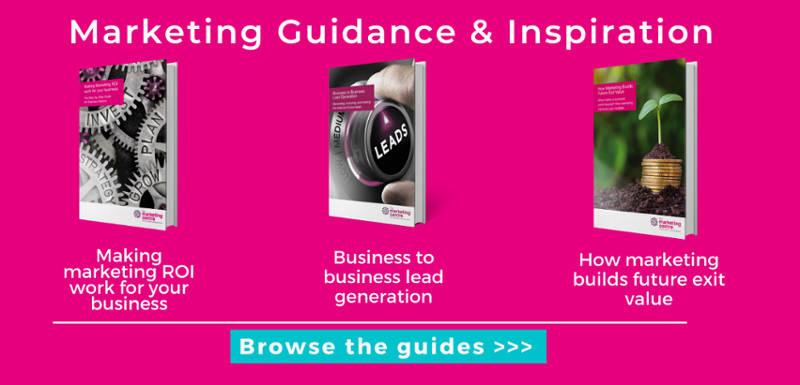Companies with a documented marketing strategy are 313% more likely to be successful in their marketing campaigns.
A marketing strategy sets the overall direction and goals for your marketing. This makes it totally different from a marketing plan, which outlines the specific actions you will take to implement that strategy.
In fact, it’s one of my pet hates – listening to people describing a marketing plan as a strategy. This has become even more common as more people become involved in marketing operations, often without formal training or qualifications.
We recently ran a series of webinars to give people ideas on how to build for the future, and you’d be amazed at how many people had never heard of an Ansoff Matrix or a Boston Matrix – or even the 4Ps.
Instead, they’re more familiar with SEO strategies and social media. But there is a world of difference between these things and a true marketing strategy.
Your marketing strategy could well look at the next few years, while a marketing plan usually describes the tactics to be used in the current year.
I build marketing strategies for our clients using our Marketing 360 model. This looks at:
- Defining your business and its products or services
- Finding the most profitable audience for them
- Winning those customers over, and then...
- Keeping them on board
Our Marketing 360 does this at a strategic level. But it also recognises that to do so effectively it needs to cover off operational and tactical elements as well.
Whatever methodology you use to develop a strategy, there are some key steps for success.
Step 1: Identify your business goals
This will allow you to define a set of marketing goals to support them.
Your business goals might include:
- Increase the total income of your company by X% over the next two years.
- Improving your gross profit by X% over the next three years.
- Or maybe you want to open three new office locations around the country
Step 2: State your marketing goals
These might include increased market penetration (selling more existing products to existing customers) or market development (selling existing products to new target markets). These marketing goals could be long-term and might take a few years to achieve.
But, whatever they are, they need to be SMART – clear and measurable and have timeframes for achievement.
A good marketing strategy won’t necessarily change every year. But you’ll need to revise it when your goals have been met, or for external reasons – perhaps a new competitor or technology. This brings us neatly on to our next point.
Step 3. Research your market
Size, growth, social trends and demographics are key elements of any response you put together in your business planning. But it’s also important to keep a constant eye on your market so you can react to any changes and keep your strategy relevant and targeted.
Covid has clearly demonstrated the need for this. There aren’t many businesses that have successfully weathered that particular storm without adapting their business strategy.
For me, there have been two types of successful businesses through Covid – those that were lucky enough to be in the right place at the right time, and those that reacted positively to market opportunities and made sensible decisions to develop new marketing strategies.
I’m working with a number of businesses who made some strategic moves during the initial stages of Covid, with PPE or hand sanitiser for example, which have enabled them to build whole new (and lasting) routes to market.
We also all know that there are supply problems in the construction sector. One building supplies firm I’m working with was cash rich and took a strategic decision to buy forward huge amounts of stock. This has enabled them to take advantage of scarcity in the supply chain and win a whole load of new customers, and these customers will stay with them long into the future.
Step 4. Profile your best customers
These short-term opportunities shouldn’t deflect you from your core business. You always need to remember who your best customers are.
Give them personas. Use your market research to look at their real needs and buying patterns. Make sure that all this is clearly stated in your marketing strategy so that it comes through in your targeting and messaging.
Step 5. Profile your competitors
Identify their products, supply chains, pricing, their marketing tactics and marketing claims.
This will point you towards your own competitive advantage – what sets your business apart from your competitors.
You may also want to identify the strengths and weaknesses of your own internal processes to help improve your performance compared with your competition.
But again, make sure you are thorough with this. The sales team may well have some useful input, but relying solely on their viewpoints may just give you a bum steer. So there’s a real role for market research here to make sure that you get your real competitive differentiation. A lack of genuine differentiation makes the job of the sales team even harder.
Step 6: Develop strategies and plans to support your marketing goals
List your target markets and devise a set of strategies to attract and retain them.
To my mind there’s no substitute here for the 4Ps of the marketing mix: Product, Price, Place and Promotion. Many people argue that there should be 7 Ps, adding in People, Process and Physical Evidence.
Whether you use 4Ps or 7Ps, if you use them as a guide then your marketing plans should be easier to develop.
But, if you haven’t diligently developed your marketing strategy in the first place, the whole thing could end up as a leaky and very expensive bucket.
How do you know when you’ve been successful? The tactics you choose need to be measured against your objectives so it makes sense to test and adjust constantly.
And don’t sit on your laurels, thinking you’ve got the job done. Things change all the time so keep your ear to the ground. In fact, I think there’s a strong case for always setting 5 or 10% of your execution budget for experimentation. That in itself will keep things fresh and help you stay ahead of the pack.
Don’t miss out on more insight from Tim. You can find his full podcast here.





